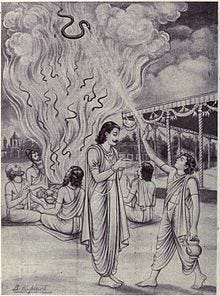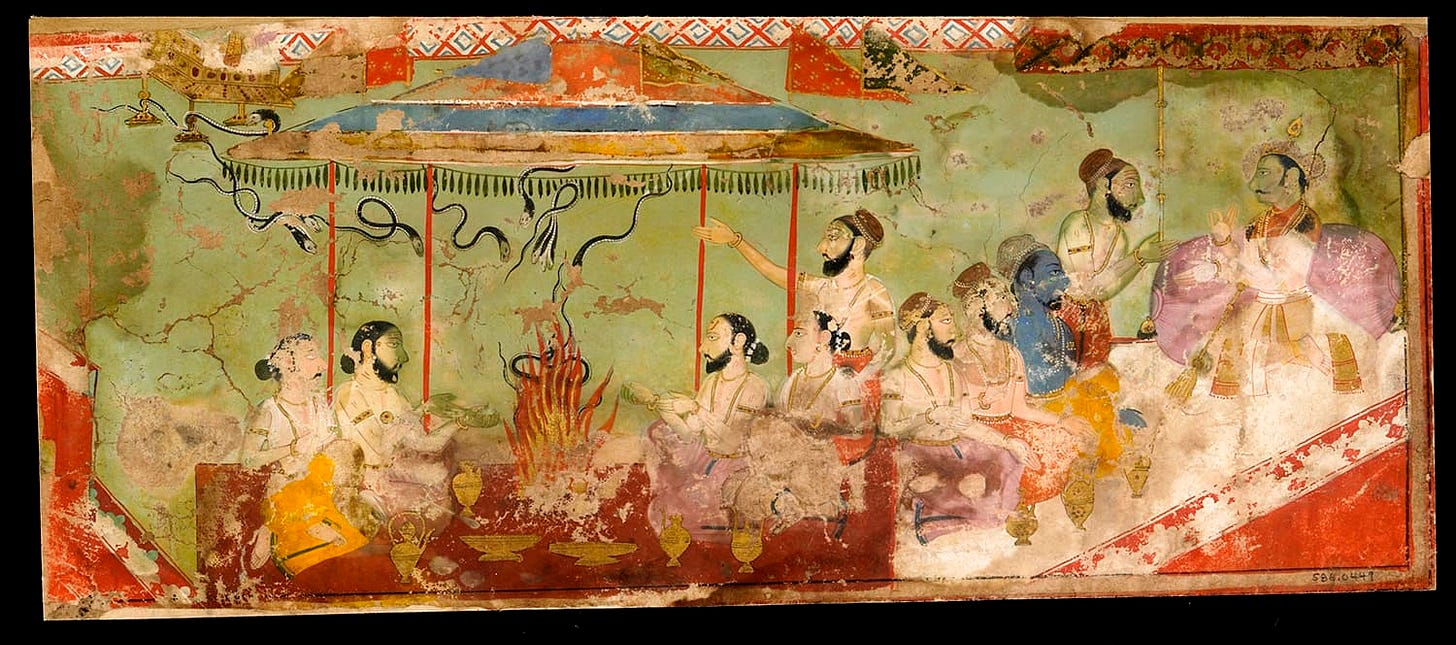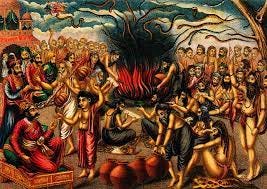The Mahabharata is the longest poem written in the history of world literature. A large number of people in India believe it to be a part of ‘Itihas’ which etymologically means, it has happened. Although the archaeological evidence for this belief is debatable, but it is so for the existence of God as well. For me, the fact that the narrative and stories have existed for the last 5000 years is sufficient evidence that this might have happened. As I told you, I am a student of literature. Amongst many concepts that allow one to enjoy literature, one of the most important is ‘willing suspension of disbelief’. The concept, brought to light by that stalwart of Romantics, S.T. Coleridge, has been practiced in India for centuries. We believe in the stories of these epics because we want to and that is all the reason one needs to establish faith. This is how the stories have been passed on, from generation to generation.
Through the generations, the epic changed its form. Either due to the politics of language and literature or due to the politics of power. Nonetheless, the basic plot remained the same and is known to most people. However, there are many interesting facts about the epic which are still not known. Such as the fact that the Bhagavad Gita is a part of the Mahabharata and not a separate book. Similarly, Krishna first appeared in the epic, and the tales of his childhood, his life at Vrindavan, and his relationship with Radha are all a part of Harivamsha which was narrated at a royal gathering during the events of the Mahabharata. Just like this, there is a common misconception that the Mahabharata starts with King Shantanu’s marriage to Ganga. But the Mahabharata is not a linear narrative but an inverse one. It begins from the end. Over the years, to make it simpler, it was told linearly. Rarer versions begin the narrative from ‘Sarpa Satra: The Great Snake Sacrifice’. This is where we shall also begin our journey.
नारायणं नमस्कृत्य नरं चैव नरोत्तमम् |
देवीं सरस्वतीं व्यासं ततो जय मुदीरयेत् ||
The shloka is an invocation to Narayana, the caretaker of the universe, Devi Saraswati, the goddess of knowledge, and Vyasa, the great poet. Before we begin our stories, I believe it is essential to acknowledge the masters and creators of this great epic.
And so we begin…
Raja Janmejaya, the king of Hastinapur and scion of the Kuru clan, ascended the throne after his father King Parikshit died of a snakebite. The king was a child when his father passed away. After ascending the throne, the king asked his council of ministers to provide the details of his father’s death as it seemed unlikely that the great Parikshit would die of such a trivial thing as a snakebite. Janmejaya’s ministers informed him that it was not a random snake that bit the king, but Takshak, a leader of the Nagas. Amongst the ministers was Uttanka who was also once cheated by Takshak. Uttanka advised King Janmejaya that the Nagas should be taught a lesson and the death of King Parikshit should be avenged. The details of his father’s death and provocation by Uttanka led Janmejaya to take the fierce vow of avenging his father by killing Takshak and exterminating the Nagas through Sarpa-Satra, the great snake sacrifice.
Janmejaya was a noble king, and the power of his kind actions was such that he was sure to get what he demands from the gods. For the sarpa-satra, the king assembled the Rithwiks, the Brahmana scholars of Puranas and Vedas. In the presence of the Rithwiks, Janmejaya began the yagna. The power of mantras was such that snakes were pulled from the farthest corners of the kingdom. Like gravity, the mantras pulled the snakes, and they were engulfed in the sacrificial fire. Fearing the yagna, Takshak ran to Indra and asked for his protection as they were friends once upon a time. Indra, the king of gods, tried to protect Takshak by hiding him in his upper garment. When the news reached Janmejaya, he called upon the king of gods too through the yagna. The gods cannot deny such an invitation invoked through the power of yagna. Indra reached the site of Yagna but fearing Janmejaya’s powers, eloped from there leaving Takshak.
A wriggling Takshak was slowly dragged to the fire. Right before he was about to fall, a voice commanded him to stay. The power of the voice overpowered the mantras and Takshak’s pull ceased. He was suspended in the air right above the flames of the sacrificial fire. The entire gathering looked for the source of the voice, which belonged to a teenage boy. The boy stood in the middle of the hall. He was a model of austerity and his face exuded knowledge. King Janmejaya demanded the boy’s introduction and the reason for which he had stopped the yagna. The boy introduced himself as Astika, son of the Naga princess Jaratkaru and Rishi Jaratkaru1, and that he was the nephew of Vasuki, the king of Nagas.


Astika exalted the King and the Rithwiks and paid greetings to the gathering. He extolled the king’s virtues and his actions and demanded that the king hear him once before continuing the sacrifice. The boy’s countenance pleased King Janmejaya immensely. He welcomed the brahman and asked him to seek a boon that he would grant for sure. As a boon, Astika asked that the snake sacrifice be stopped, and Takshak’s life be saved. Janmejaya told the boy that he would give him all the riches and gold that he wants but he could not stop the sacrifice. Snakes of all kinds kept getting pulled to the fire as the mantras intensified but Takshak remained suspended in the air. Astika’s powers were such that the mantras were not able to overcome them. At this miracle, the Rithwiks advised the king to grant his boon to Astika. Only then the ongoing carnage was going to stop. Realizing that Astika was no ordinary boy, King Janmejaya complied with his request and granted him the boon. He ordered the yagna to be stopped. Takshak’s life was thus saved and Astika brokered peace between King Janmejaya and the Nagas. It was decided that the Nagas will not harm any humans and the humans, in return, will live with Nagas in peace. King Janmejaya was extremely impressed by Astika’s compassion and invited him to be a part of his court, which Astika graciously accepted.
The king, although, agreed to the peace treaty with the Nagas, was still confused as to why Takshak committed the heinous crime of killing King Parikshit. He raised this question to the Sabha. The answer was given by sage Vaishampayana. The great sage told the king that Takshak’s actions were a consequence of his great-grandfather Prince Arjuna’s actions. Janmejaya was intrigued and asked the sage to narrate the story of his great-grandfather. At this, Vaishampayana narrated the story of Mahabharata which he had heard from Krishna-Dvaipayana, better known as Ved-Vyas, while he dictated the story to his scribe, Ganesha.
This is the point where the Mahabharata begins. The story of the great war starts with carnage and the killing of a tribe. Your actions will impact your family, friends, and by extension, the entire tribe. Takshak’s actions lead to the death of his children as does Arjuna’s. Later, through the stories, we will learn what Arjuna had done which resulted in the death of his grandson, Parikshit. The exchange between Astika and Janmejaya tells us that ‘an eye for an eye’ will only result in the world turning blind. Forgiveness is essential. Takshak killed Parikshit to take revenge on Arjuna. Had Janmejaya killed Takshak, his children might have continued the cycle by killing Janmejaya.
The story tells us that violence is a necessary evil in this world. But it cannot be countered with violence. All creatures have a violent side. As humans, we can control that side. If we let our primal self overpower our senses, the world would be nothing, but a large, desolate land strewn with dead bodies.
On a personal level, the story explains that there will always be people who would act in a way that would hurt us or our families. If we decide to act in a similar way to seek revenge, it will only increase animosity instead of establishing peace.
The epic begins by teaching forgiveness and continues to teach it through various other episodes. We cannot reach a brighter horizon by harboring revenge and hatred in our hearts.
Dear readers, this is my take on this story. What is yours? I would love to know your thoughts and interpretations. You might have heard a different version of the story too. Do share it in the comments so we all may get various perspectives.
The name of the Naga Princess was the same as the Rishi she married.





Very Impressive …a great initiative… Totally agree with your interpretation and perspective of Mahabharata’s Sarpa Sutra.
Am proud to have a creative in our family …continue to embrace your creativity. Wish you luck and success 💐💐💕💕
Beautifully told…..got immersed in it and got to learn some thing new about the epic !